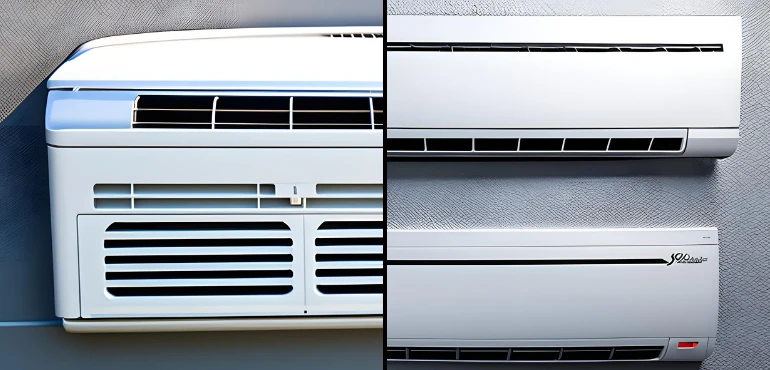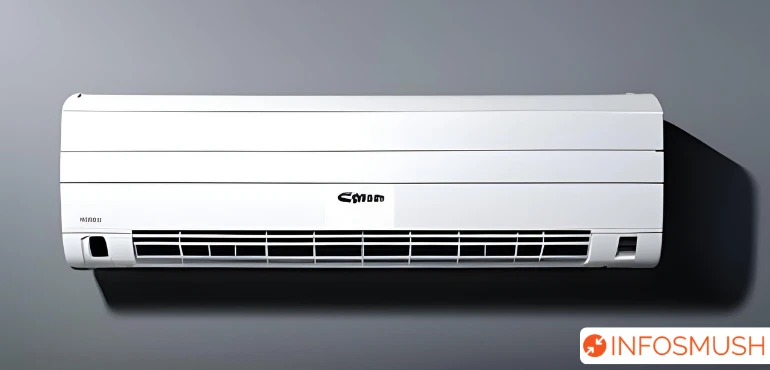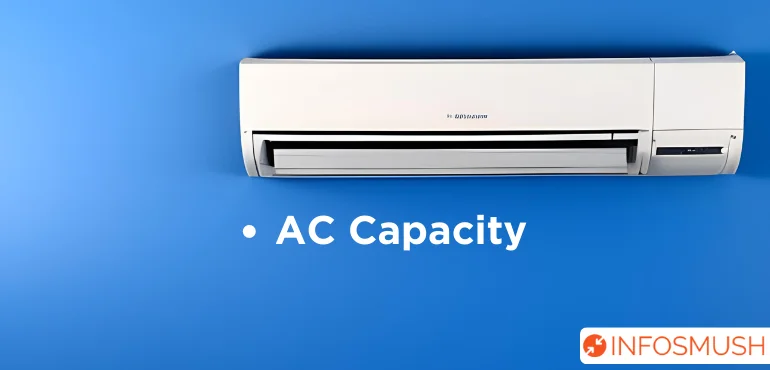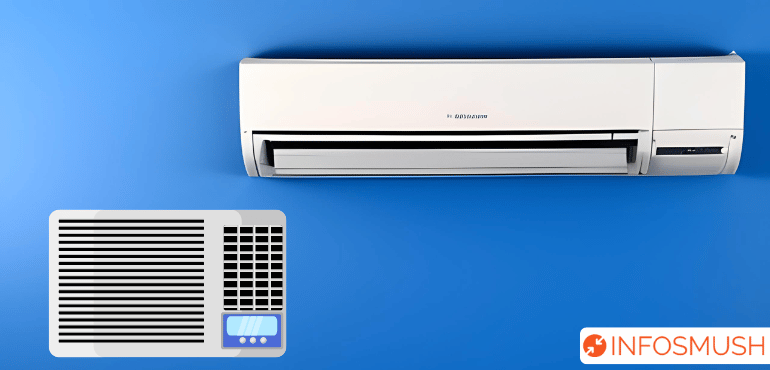As the scorching heat of summer approaches, it’s time to gear up and prepare for the battle against rising temperatures. And what better way to beat the heat than with a reliable and efficient air conditioner (AC) that keeps your living space cool and comfortable? However, with a myriad of AC options available in the Indian market, choosing the right one can be a daunting task. That’s why we’ve created this AC Buying Guide for 2023, designed to help you navigate through the latest advancements and find the perfect AC that suits your needs. From split ACs to window units, from energy efficiency to cooling capacity, we’ll explore the essential factors to consider when making your AC purchase decision. So, sit back, relax, and let us guide you toward a cool and refreshing summer experience.
1. Select the Type of AC For Your Room

When it comes to finding the ideal air conditioner (AC) for your room, making the right choice is crucial. Each type of AC offers distinct advantages and is designed to suit specific room sizes and cooling requirements. Whether you’re looking for a compact window unit or a versatile split AC, this comprehensive guide for 2023 will assist you in selecting the perfect AC that perfectly fits your room. We’ll delve into the various types of ACs available in the market, considering factors such as room size, installation options, and cooling efficiency. By the end of this guide, you’ll be equipped with the knowledge to make an informed decision and create a comfortable oasis within the confines of your own space.
Split AC

A split AC is like having a cool superhero at home! It has two parts: one part stays outside your room (like a quiet protector) and the other part is inside (like a cool breeze generator). The outside part does all the hard work, making the air cold, and sends it inside through pipes. The inside part then spreads the cool air throughout your room, making it nice and comfortable. So, you can enjoy the superpower of staying cool and refreshed even when it’s hot outside!
Who Should Buy a Split AC:
- Those with Larger Rooms: Split ACs are well-suited for cooling larger rooms or open spaces. If you have a spacious living room, a master bedroom, or an open-plan area, a split AC can efficiently distribute cool air throughout the space.
- Individuals Seeking Quieter Operation: If you value a quiet and peaceful indoor environment, a split AC is an excellent choice. With the compressor located outside the room, split ACs significantly reduce noise levels indoors, allowing you to relax or sleep undisturbed.
- Those with Modern Interior Designs: Split ACs are aesthetically pleasing and often complement modern interior designs. With the indoor unit mounted on the wall or ceiling, they provide a sleek and streamlined look that blends seamlessly with contemporary decor.
- Those Wanting Zoning Capabilities: If you desire the flexibility to control the temperature in different rooms individually, a split AC with multiple indoor units is an ideal option. This zoning capability allows you to personalize the cooling experience based on individual preferences and needs.
Who Shouldn’t Buy a Split AC:
- Those with Limited Installation Space: If you have limited wall or ceiling space for installing the indoor unit, a split AC may not be practical. It’s essential to assess the available space and ensure that the installation of the indoor unit is feasible in your room.
- Individuals on a Tight Budget: Split ACs generally have a higher initial cost compared to window ACs. If budget constraints are a significant factor for you, a window AC might be a more affordable option that still provides efficient cooling for smaller rooms.
- Those Seeking Easy Installation: While split ACs offer various advantages, they typically require professional installation, which can be more complex and costly compared to window ACs. If you prefer a simpler installation process, a window AC is a more straightforward option.
Pros:
- Efficient Cooling: Split ACs are known for their efficient cooling performance, making them suitable for larger rooms or open spaces.
- Noise Reduction: The compressor, which produces the most noise in an AC, is located outside the room in split ACs. This results in quieter operation indoors.
- Aesthetically Pleasing: Split ACs have a sleek design and blend well with modern interiors, thanks to their indoor unit mounted on the wall or ceiling.
- Zoning Capabilities: Split ACs with multiple indoor units allow for zoning, enabling you to control the temperature individually in different rooms.
Cons:
- Higher Installation Cost: Split ACs generally require professional installation, which can be more expensive compared to window ACs.
- Limited Placement Options: Split ACs require wall or ceiling space for installation of the indoor unit, which might not be feasible in some rooms.
- Higher Initial Investment: Split ACs tend to have a higher upfront cost compared to window ACs.
Window AC

A window AC is like a cool machine that sits on your window or a special opening in the wall. It has all the parts inside one box, including the cooling system and fan. When you turn it on, it pulls in warm air from your room, cools it down, and blows the cool air back into the room. It’s easy to install and perfect for smaller rooms. Just place it in the window, plug it in, and enjoy the refreshing breeze it brings.
Window ACs are suitable for smaller rooms, making them a good choice for bedrooms, home offices, or studio apartments. They are cost-effective, making them ideal for individuals on a budget. Additionally, window ACs are easy to install, allowing for a hassle-free setup without the need for professional help.
Pros of Window ACs:
- Cost-Effective: Window ACs are generally more affordable than split ACs, making them a budget-friendly option for cooling smaller spaces.
- Easy Installation: With their simple design and installation requirements, window ACs can be easily installed by the user, saving both time and money.
- Space-Saving: All components of a window AC are housed in a single unit, making it a space-saving option for rooms with limited floor space.
Cons of Window ACs:
- Cooling Capacity Limitations: Window ACs may not be as effective in cooling larger rooms or open spaces compared to split ACs. They are best suited for smaller areas.
- Noise and Vibrations: Since the entire AC unit is installed inside the room, window ACs can generate more noise and vibrations compared to split ACs.
- Limited Placement Options: Window ACs require a window or a dedicated wall opening for installation, which limits their placement options compared to split ACs.
2. Which AC Capacity is Best For Your Room

The cooling capacity of an air conditioner (AC) is an essential factor to consider when purchasing one for your space. It determines how effectively an AC can cool a room. Cooling capacity is typically measured in British Thermal Units (BTUs) or Ton.
To choose the right AC with the appropriate cooling capacity, you need to consider the size of your room. A room’s size is measured in square footage (sq ft). Here’s a general guideline to help you estimate the cooling capacity needed for your room:
[su_list icon=”icon: arrow-circle-right” icon_color=”#e76b24″]
- Calculate the square footage of your room by multiplying its length and width measurements.
- Refer to a cooling capacity chart or table provided by AC manufacturers. These charts usually suggest the appropriate cooling capacity in BTUs or tons based on room size.
- Select an AC with a cooling capacity that matches or slightly exceeds the recommended BTU/ton value for your room size. If the cooling capacity is too low, the AC may struggle to cool the room adequately, while an oversized AC can lead to inefficient cooling and higher energy consumption.
[/su_list]
You can look at the table below to know the optimal BTU and Ton for your room size:
| Room Size | BTU | Tonnage |
|---|---|---|
| 100-120 sq. ft. | 6,000 BTU | 0.5 Ton |
| 120-150 sq. ft. | 9,000 BTU | 0.75 Ton |
| 150-180 sq. ft. | 12,000 BTU | 1.00 Ton |
| 180-250 sq. ft. | 18,000 BTU | 1.50 Ton |
| 300-350 sq. ft. | 24.000 BTU | 2.00 Ton |
| 350-500 sq. ft. | 36,000 BTU | 3.00 Ton |
It’s important to note that factors such as insulation, ceiling height, sun exposure, and room usage can affect the cooling capacity required.
3. Consider the Power Consumption of the AC
When choosing an air conditioner (AC) in India, it’s essential to consider its power consumption to ensure energy efficiency and cost-effectiveness. One of the key factors to evaluate the energy efficiency of an AC is its star rating. Here’s what you need to know:
Star Rating: ACs are assigned star ratings based on their energy efficiency. Higher star ratings indicate greater energy efficiency, meaning the AC consumes less power to deliver the same cooling output.

Calculating Power Consumption: Power consumption is measured in units of electricity, typically kilowatt-hours (kWh). To estimate the power consumption of an AC, you can multiply its input power (in kilowatts) by the number of hours it operates daily.
This is the formula to calculate monthly power consumption:
Units per month = (kW of AC) * (Daily running hours) * (Number of Days in Month)Energy Efficiency Comparison: Each increase in star rating represents an improvement in energy efficiency. For example, a 5-star AC is more energy-efficient than a 4-star AC, which, in turn, is more efficient than a 3-star AC. Higher star ratings indicate that the AC can provide the same cooling output while consuming less power.
Example:
Average power consumption of Split AC.
| Star rating | 1 Ton | 1.5 Ton | 2 Ton |
| 1 Star | 1100W | 1651W | 2200W |
| 2 Star | 1036W | 1554W | 2071W |
| 3 Star | 940W | 1408W | 1878W |
| 4 Star | 782W | 1174W | 1565W |
Average power consumption of Window AC:
| Star rating | 1 Ton | 1.5 Ton | 2 Ton |
| 1 Star | 1355W | 2032W | 2710W |
| 2 Star | 1279W | 1918W | 2557W |
| 3 Star | 1174W | 1761W | 2348W |
| 4 Star | 1100W | 1650W | 2200W |
| 5 Star | 1065W | 1599W | 2131W |
Considering Price Differences: While higher star-rated ACs offer better energy efficiency, it’s crucial to consider the price difference. ACs with higher star ratings are often more expensive upfront compared to lower-rated models. However, the energy savings over the lifespan of the AC can offset the initial cost difference. Therefore, it’s essential to assess your budget and weigh the long-term energy savings against the initial investment.
By considering the star rating and calculating the power consumption, you can choose an AC that strikes the right balance between energy efficiency and affordability. Keep in mind that the actual power consumption may vary based on factors such as usage patterns, temperature settings, insulation, and climate conditions.
It’s advisable to look for AC models with higher star ratings to reduce energy consumption and minimize your carbon footprint. However, it’s also important to consider the price difference and analyze the potential energy savings over time to make an informed decision that aligns with your budget and sustainability goals.
4. Choose Inverter or Non-Inverter AC
Inverter AC and Non-Inverter AC are two different types of air conditioning systems based on the technology used to regulate compressor speed and control cooling output. Here’s a brief explanation of each:
Inverter AC
Inverter ACs utilize advanced technology that allows the compressor to operate at variable speeds. Unlike non-inverter ACs, which have fixed compressor speeds that switch on and off to maintain temperature, inverter ACs continuously adjust the compressor speed to match the cooling demand.
The key features of inverter ACs include:
- Energy Efficiency: Inverter ACs are known for their energy efficiency as they can vary the compressor speed based on the cooling requirement, resulting in less energy wastage.
- Precise Temperature Control: Inverter ACs provide more precise temperature control and maintain a consistent indoor climate by making gradual adjustments to the cooling output.
- Quieter Operation: The variable-speed compressor operation in inverter ACs reduces noise levels compared to non-inverter ACs, providing a quieter and more comfortable environment.
- Faster Cooling: Inverter ACs can achieve faster cooling by operating at higher compressor speeds during the initial phase, allowing the desired temperature to be reached more quickly.
Non-Inverter AC
Non-Inverter ACs are the traditional and more common type of air conditioners. These ACs have a fixed-speed compressor that turns on and off to maintain the desired temperature. When the temperature rises above the set level, the compressor switches on at full speed until the desired temperature is reached, and then it turns off.
Key features of non-inverter ACs include:
- Cost-Effective: Non-inverter ACs are typically more affordable than inverter ACs, making them a popular choice for those on a tighter budget.
- Simple Design: Non-inverter ACs have a simpler design and are relatively easier to maintain and repair compared to inverter ACs.
- Wide Availability: Non-inverter ACs are widely available and come in various models and capacities to suit different cooling needs.
While non-inverter ACs are budget-friendly, inverter ACs are known for their energy efficiency and precise temperature control. Inverter ACs are a recommended choice for those seeking long-term energy savings and a more comfortable cooling experience.
There is another type of AC that uses Dual Inverters
Dual inverter ACs utilize advanced technology with two compressors to enhance energy efficiency, cooling performance, stability, and noise reduction. They offer precise temperature control, faster cooling/heating, quieter operation, and increased durability. Dual inverter ACs are known for their superior energy efficiency, making them a great choice for those seeking long-term cost savings and optimal comfort. While they may come at a slightly higher price, the benefits of dual inverter technology justify the investment for those prioritizing enhanced cooling performance and energy efficiency.
5. Aluminum vs Copper Coil
Aluminium Coil and Pipe: Aluminium is a lightweight and cost-effective option for AC coils and pipes. It has good heat transfer capabilities and is naturally resistant to corrosion. However, it can be susceptible to formicary corrosion over time, and it has lower strength compared to copper.
Copper Coil and Pipe: Copper is known for its excellent heat transfer properties, durability, and resistance to corrosion. It has a longer lifespan and is stronger than aluminum. However, copper is more expensive and heavier than aluminum.
In short, copper is more expensive but the better choice when buying an AC in India.
6. After-Sales Service & Service Centers
This is the most important aspect that any best AC Buying Guide(like this one) should tell you to consider. Because this will ensure that you will not spend weeks for months if anything unfortunate happens to your AC.
Do consider these facts when you’re out buying a brand-new AC:
- After-Sales Service: Good after-sales service is crucial for any appliance, including ACs. It involves the support and assistance provided by the manufacturer or authorized service providers after the purchase. This includes services such as installation, maintenance, repairs, and warranty support.
- Service Center Availability: It’s important to check the availability of nearby service centers for the AC brand you are considering. Having a service center in close proximity ensures convenient access to technical assistance and support whenever needed. This can save time and effort in case of repairs or maintenance requirements.
- Timely Support and Response: Reliable after-sales service entails prompt response and timely resolution of customer queries, complaints, or service requests. It is beneficial to choose a brand that has a reputation for providing efficient and customer-friendly after-sales support.
- Authorized Service Providers: It’s advisable to opt for AC brands that have a network of authorized service providers. Authorized service centers employ trained technicians who have the expertise to handle specific brand models, ensuring quality repairs and maintenance.
- Warranty Coverage: ACs typically come with a warranty period that covers certain repairs or part replacements. Understanding the warranty terms and conditions is important, including the duration, coverage, and any additional services offered.
Considering after-sales service and the availability of nearby service centers ensures that you have access to reliable technical support and assistance when required. It provides peace of mind knowing that you can easily reach out to trained professionals in case of any issues or maintenance needs. Researching the reputation of the brand and their after-sales service can help you make an informed decision when selecting an AC.
7. Other Desirable Features in an AC
Inbuild Dust and Bacteria Filters
ACs with inbuilt dust and bacteria filters have an additional filtration system that captures dust particles and inhibits bacterial growth. These filters improve indoor air quality by removing allergens and pollutants. Regular maintenance and replacement of the filters are necessary for optimal performance. This feature contributes to a healthier and more comfortable indoor environment, particularly beneficial for individuals with respiratory conditions or allergies. Some models may offer additional features such as activated carbon filters or ionizers for enhanced air purification.
So when you are buying an AC keep that in mind.
Four-Way Swing:
ACs with a four-way swing feature allow the air to be distributed in multiple directions, ensuring uniform cooling throughout the room. This feature helps eliminate hotspots and creates a more comfortable environment.
WiFi Connectivity:
ACs with WiFi connectivity enable you to control and monitor the unit remotely using a smartphone or other devices. This feature allows for convenient operation and temperature adjustments even when you’re not physically near the AC.
Auto Start and Auto Off:
The auto start feature allows the AC to automatically resume operation after a power outage, maintaining your preferred settings. Auto off, on the other hand, automatically switches off the AC when the desired temperature is reached, helping conserve energy.
Timer Function:
The timer function allows you to set a specific time for the AC to turn on or off. This feature provides flexibility in scheduling cooling cycles, helping you save energy and ensure a comfortable environment upon arrival.
Turbo Mode:
The turbo mode in an AC enhances the cooling performance by maximizing the airflow and compressor speed. It quickly cools the room during hot weather or when you need immediate relief from the heat.
Smart Features: Some AC models come with smart features that allow control via mobile apps, voice assistants like Alexa or Google Assistant, or even integration with smart home systems. These features provide convenience and flexibility in operating and managing the AC.
Dehumidification: Must Have For Humid Conditions
Dehumidification is an important feature found in some air conditioners (ACs) that helps remove excess moisture from the air. In simple terms, it works like a “moisture-absorber” for your room. When the AC is set to the dehumidification mode, it actively pulls out the extra moisture present in the air, making it less humid and more comfortable indoors.
The benefit of dehumidification is that it helps address common issues caused by high humidity, such as that sticky feeling, musty smells, and the growth of mold or mildew. By reducing the moisture level, the AC creates a healthier and more pleasant environment to breathe in.
It’s worth noting that dehumidification does require some additional energy, as the AC has to work harder to remove both heat and moisture. However, many AC models offer energy-saving features to balance efficiency while providing effective dehumidification.
For those living in humid climates or facing persistent moisture problems, choosing an AC with dehumidification capabilities can significantly improve indoor comfort and overall air quality.
AC Buying Guide India 2023: Conclusion
Choosing the right air conditioner (AC) for your needs is essential for a comfortable and enjoyable indoor environment. Throughout this AC buying guide, we have discussed various factors to consider when making your purchase decision. From selecting the AC type and considering its cooling capacity to evaluating energy efficiency and after-sales service, each aspect plays a crucial role in finding the best AC for you.
Whether you opt for a split AC or a window AC, it’s important to assess your specific requirements, room size, and budget. Features like dehumidification, smart capabilities, and inbuilt filters can further enhance your cooling experience and improve indoor air quality. Additionally, considering the availability of nearby service centers and the reputation of the brand’s after-sales support ensures peace of mind and timely assistance when needed.
Remember, buying an AC is an investment that should align with your cooling needs and provide long-term satisfaction. Weigh the pros and cons of each option, taking into account factors like energy efficiency, maintenance requirements, and the overall value provided by the chosen AC model.
By following this AC buying guide, you can make an informed decision that suits your specific needs and preferences. Stay cool, comfortable, and enjoy the benefits of a well-chosen air conditioner that keeps you refreshed during hot summer days.


